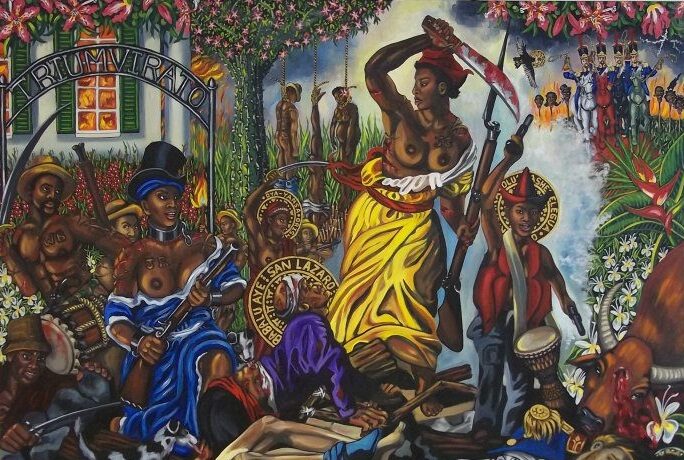Women’s Resistance to Chattel Slavery
The Repair Campaign spoke to Fiona Compton, Saint Lucian artist and historian, to discuss the role women played in resistance against chattel enslavement.
November 28, 2023

Chattel slavery was unimaginably awful for both men and women, but women carried a particularly heavy and disproportionate burden. There were many cases of sexual abuse, rape, forced pregnancies and deep psychological burdens. Black women also were often denied their agency and femininity – stripped of their choice to have children, to grow their hair, or subject to dehumanising punishments.
It is no wonder then, that women played an important role in resistance efforts – they were not passive. In fact, women have always been the epicentre, the glue, the heart of resistance. There could not have been resistance in its fullness without women.
Women were often at the centre of resistance in a variety of ways – as leaders, healers, nurturers, mothers. There are examples of women as leaders and instigators of rebellions such as Queen Nanny of the Maroons in Jamaica but there are also many instances where women found ways to engage in silent or lesser-known acts of resistance. In some cases, enslaved women refused to bear children as a form of silent protest. Low birth rates on certain plantations weren’t just due to factors like diet, they were also a result of women choosing not to have children, especially if the father was European. Additionally, women in domestic roles who had access to what enslavers ate, drank and took as medicine sometimes used poison as a means of resistance.
There are, however, several significant examples of individual women that are worth highlighting.
Flore Bois Galliard of St. Lucia
Flore Bois Galliard was an enslaved woman from St. Lucia on a plantation in Soufrière. She was of mixed heritage – her father was a French man based in Martinique and her mother was African. Her enslaver, Monsieur Bellac, was very abusive to her and she suffered continuous physical and sexual abuse until one day she retaliated by killing Mr. Bellac and setting fire to his plantation. Galliard then retreated into the woods and joined the “Nèg Mawon” (the French Creole name for the Maroons).
At that time, there was a thriving Maroon community in St. Lucia and the French Revolution was stirring up waves of revolts in the Caribbean, with significant events also unfolding in Haiti. Galliard got involved in this movement while living in the forest and rose to become one of the generals in the Nèg Mawon. They engaged in a massive battle in Soufrière against the English who were attempting to re-enslave them. Remarkably, the Nèg Mawon emerged victorious, compelling the British soldiers to leave the island. During the battle, the Nèg Mawon warriors ensured the safety of the women and children and sent them to Martinique to demonstrate that their aim was freedom and not just killing for the sake of killing.
Galliard was a key part of this movement, contributing to the abolition of chattel slavery in Saint Lucia. Although the timeline is somewhat unclear, within a span of one to three years they managed to bring a temporary end to chattel slavery on the island. However, Britain returned and re-invaded the region, and was absolutely shocked to find it was a woman who was one of their generals.
La Negra Carlota of Cuba
Carlotta of Cuba was one of the leaders of the slave rebellion at the Triunvirato plantation in Cuba. Carlotta belonged to the Yoruba tribe and was born a free woman in the Kingdom of Benin but was kidnapped and taken to Cuba.
In the 1840s, particularly in 1844 which was labelled the “year of the lash,” Cuban colonial powers believed enslaved people were plotting to kill them and attempting to end enslavement. In response, the colonizers subjected hundreds, if not thousands, of individuals—men, women and children—to severe punishment by tying them to ladders and whipping them into confessing their plot to rebel.
Carlotta was determined to retaliate. She decided first to free her friend Filomena who was imprisoned on another plantation. They realised they had the power to liberate themselves and if they banded together, they could destroy the plantations. Carlotta led this rebellion and used the “talking drums” to send messages to various plantations and coordinate their attacks.
The rebellion lasted a few days and there was a retaliation by the enslavers. Carlotta was executed in a very horrific way. They tied her hands and legs to four horses and sent the horses running in different directions. Filomena was also shot during another rebellion after Carlotta died.
I see Carlotta’s execution as a reflection of the enslavers’ fear. They understood her power so they had to execute her in the most brutal way to send a horrific message and cut down the spirit of the people. They had to do the most inhumane thing in order to dampen their spirits.
Queen Cubah of Jamaica
There is also the story of Akua or Queen Cubah of Jamaica, whose resistance took place during Takyi’s revolt in the 1700s. Akua, who was a healer, was from the Ashanti Empire in Ghana. Akua was also called the Queen of Kingston in Jamaica and was even crowned the queen through a very elaborate ceremony where she had a robe, a crown and a throne. Still, she decided to join the fight for the liberation of enslaved people in Jamaica.
Unfortunately, she was captured by the British, deported to another island and sentenced to a life of hard labour as punishment. However, as she was being deported, she bribed the sea captain to take her back around the island to go back to the fight. She could have left but she went back and risked her life to continue the fight for liberation.
Cécile Fatiman of Haiti
Cécile Fatiman you could say became the mother of the Haitian Revolution when the gathering at Bois Caïman happened in 1791.
Cécile Fatiman, was a Vodou priestess of mixed heritage. Her mother was an African woman who was sexually assaulted on a slave ship on her way to Haiti and then gave birth to Cécile. Cécile learned about Vodou and became a Vodou priestess. She, along with Boukman Dutty, partook in a ceremony to ignite the spirits of the Haitian enslaved population into resistance and revolution. She said that she was taken by the spirits, Erzulie, when they sacrificed the pig. She started to speak about a rebellion, speak about resistance and speak about freedom. And this was the birth of the Haitian Revolution.
Without Cécile, there might not have been a Haitian Revolution.
The Queens of the Fireburn
This happened after chattel slavery had ended in the Danish Virgin Islands which include St. Croix, St. Thomas and St. John. On the island of St. Croix, formerly enslaved people were fighting for better rights and better pay because the situation hadn’t improved even though they were emancipated. The tipping point to this already dire situation came when a rumour spread that a black man was beaten and killed by the police. In actuality, although he was beaten up, he was partially inebriated. Their protest started in response to this act of police brutality.
In protest, a group of women led a rebellion and set fire to two thirds of the island. They are known as The Queens of the Fireburn. The well-known queens were named Mary, Agnes and Susanna but there was actually a fourth queen named Mathilda, who was only 15-years-old. They led the rebellion but made sure not to set fires to the properties of the people who treated them well.
As a result, the Danish had to flee. They left for several months and had to call in reinforcements from the French and the English in order to take back the country. When the colonisers regained control of the country, the four women were sent to prison in Copenhagen and sentenced to a life of hard labour.
It is worth pointing out that this was a rebellion led by four women. A lot of times you’d find women joining in with other people, but this was principally led by these four women.
La Mulatresse Solitude of Guadalupe
In the late 18th century, into the early 19th century, chattel slavery had been abolished in France and plantation workers in Guadeloupe were leaving plantations in large numbers. Because plantation owners were desperate for workers, Napoleon Bonaparte decided to reinstate chattel slavery in Guadeloupe. But La Mulatresse Solitude, who was heavily pregnant, and her partner Congo, resisted the French army, liberated themselves from their plantation and moved to the forest.
It is said that Solitude was the master of the machete and would use her machete to intimidate French soldiers during her many battles against the French. During one battle, a French platoon cornered her along with Louis Delgrès, another leader of the resistance. They surrounded themselves with barrels of gunpowder and decided to blow themselves up. All 400 of them.
As they say, “La liberté ou la mort” – freedom or death, right?
Everybody died but Solitude survived. They captured her, put her in jail and waited for her to give birth. The day after she gave birth, they executed her and sold her child into enslavement, but nobody knows what happened to her child after that.
